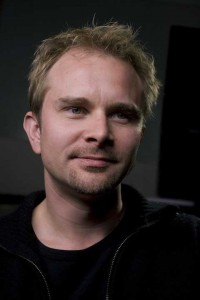
The ambitious Cloud Atlas has been receiving critical plaudits, mostly for devising a way to take author David Mitchell’s famously unfilmable Booker Prize nominee and turn it into a film. The six storylines, spanning past and future settings, were overseen by two production teams, each overseen by a different direction unit. One unit was run by Tom Tykwer (Run, Lola Run), the other by siblings Lana and Andy Wachowski, the creative minds behind a series of films having to do with a similar inter-connectedness, The Matrix trilogy. Interconnectedness and the way that energies and heartbreaks migrate from one moment in history to the next is thematic in Cloud Atlas and its overlapping, interconnected narratives.
It should be no surprise then that the visual effects for such a film – which takes on a variety of styles and aesthetics, from historical recreation to future dystopia – would prove to be equally ambitious, and unsurprisingly, wind up with two men credited as visual effects supervisors Dan Glass and Stephane Ceretti.
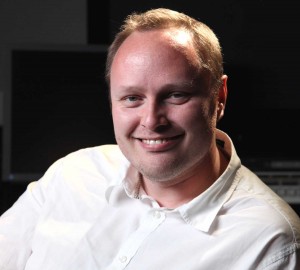
The pair had worked together on Batman Begins, in which Glass was the overall supervisor, and Ceretti supervised too for French FX house BUF Compagnie.
Glass said the work here was really about being sensitive to production design. But perhaps unlike that story of the singular, brooding Bruce Wayne, with Cloud Atlas they had the task of managing the multiple aesthetics of the half-dozen narratives that make up the film. He notes that in the book, chapters were written in distinct styles – but the directors wanted more overall cohesion for the film, even though there were two production designers, Hugh Bateup and Uli Hanisch, and two directors of photography, John Toll and Frank Griebe, to go with the two units. However, the visual effects and editorial departments were run as a single team to help bring the movie together at the end.
“I would say there were two phases,” Ceretti said. “Dan was in pre-production, way before I joined.” But as soon as he was aboard, found all three directors were coming to him.
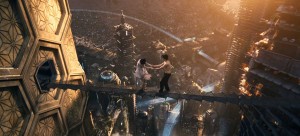 “The actual way of (dividing the responsibilities of visual effects supervisor) was to divide the work by vendors,” Ceretti said. Glass, then, oversaw the work from Method Studios, while Ceretti tended to a lot of the German vendors working on the Tykwer side, like Trixter Film and ARRI VFX.
“The actual way of (dividing the responsibilities of visual effects supervisor) was to divide the work by vendors,” Ceretti said. Glass, then, oversaw the work from Method Studios, while Ceretti tended to a lot of the German vendors working on the Tykwer side, like Trixter Film and ARRI VFX.
Even though the stories were stylistically different, Ceretti said there were little things helping to glue the stories together that the VFX crew would need to fine-tune in post, like matching motion in an across-the-centuries cut, where an unfurled 19th century sail is matched to escapees on a neon bridge in a futuristic Seoul. Sets were also reused so that visually, the architectural bones would match from story to story as well.
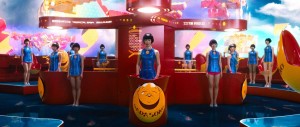 Since, in Glass’ words, a lot of the “locations didn’t exist,” such thematic overlays become the province of the visual effects folks in post, which included the use of matte paintings, to convey, for example, San Francisco in both 1849, and 1973.
Since, in Glass’ words, a lot of the “locations didn’t exist,” such thematic overlays become the province of the visual effects folks in post, which included the use of matte paintings, to convey, for example, San Francisco in both 1849, and 1973.
But the other famously repeating motif in the film is the use of the same troupe of actors to play most of the roles in most of the eras. This lent a sense of souls re-appearing and re-learning lessons – and finally granting epiphanies to said souls – over the ebb and flow of centuries. This meant that actors could sometimes play different genders and often played different races than their own. Glass noted the directors didn’t want the cross-casting to become insulting or offensive. So the FX folk would often add touches to what the make-up people were doing, enhancing the work of Jeremy Woodhead and Daniel Parker’s concurrent make-up and prosthetic teams.
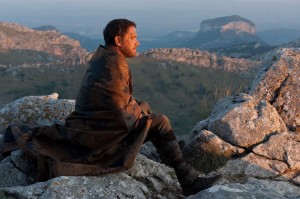 They also called on Lola FX to help with a Nurse Ratched-y turn by Hugo Weaving, who plays not simply a man in drag, but a female nurse, in one sequence. Since Lola was known for its “skinny Steve Rogers” work in Captain America: The First Avenger, here they similarly helped feminize Weaving’s face to make him more believable in the role.
They also called on Lola FX to help with a Nurse Ratched-y turn by Hugo Weaving, who plays not simply a man in drag, but a female nurse, in one sequence. Since Lola was known for its “skinny Steve Rogers” work in Captain America: The First Avenger, here they similarly helped feminize Weaving’s face to make him more believable in the role.
“These souls are traveling through time,” Ceretti said. He emphasize that they didn’t want to lose the actor completely in each role. “When you see Hugo as an old nurse – it’s still Hugo,” Ceretti said.
But in spite of the make-up enhancement, and the futuristic sequence, which Glass said drew some inspiration from Blade Runner, and the even more futuristic post-apocalypse story, Ceretti maintains this wasn’t a visual effects movie – it’s driven by story and character.
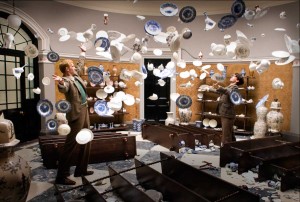 For Glass, he described his previous film, Tree of Life, as attempting to explain the sum of existence. Cloud Atlas, then, attempts the sum of human existence.
For Glass, he described his previous film, Tree of Life, as attempting to explain the sum of existence. Cloud Atlas, then, attempts the sum of human existence.
He said the process of the film was unique, as was the subject matter. Heck, the three directors even approached the project in a non-Hollywood way: instead of handing Glass the script first, they handed him a copy of the book.
“It’s an ambitious and different project done with a lot of heart,” Ceretti said. Now to see how it gets taken to heart with an array of potential award season nominations in front of it.





